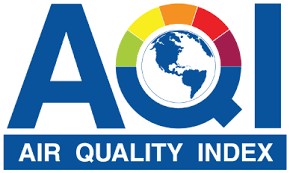This is part 3.
Click on the links below
for the other parts.
6. The UK revised DAQI
In the UK the Department for Environment, Food and Rural Affairs (DEFRA) publishes since 2013 the revised Daily Air Quality Index (DAQI); the first DAQI was introduced in 2012. The DAQI has 4 quality levels (from best to worst: LOW, MODERATE, HIGH, VERY HIGH) and the index runs from 1 to 10. It is based on concentrations of O3, NO2, SO2 and PM’s (PM10 and PM2.5) measured in ug/m3 (CO has been removed in the revised DAQI).
The following table gives the break-points (link):
The first comment should be that the “band” qualifiers correspond to the numerical index, and that “Low” means low index = good air quality conditions. The break-points are not proportional to the concentration: note that for O3 index 2 spans over 33 ug/m3, whereas that index 4 extends over 20 ug/m3. The pollutant with the highest index defines the published DAQI.
Ozone concentrations are only taken as 8h running mean. The color levels used for the different bands and subdivisions are different from those of EPA and China, and the health messages attached reflect the differences between individuals at risk and the general population:
There are at least two methods to view live DAQI data:
1. use a Google Earth KMZ file (link)
2. go to the interactive map (link):
Clicking on a station gives very detailed information, a shown below (all lines are active links):
Conclusion:
- Care should be taken to not confuse a “LOW” index with “low air quality”.
- Not further subdividing the “Very high” category is a good decision.
- 10 different color-shades are in my opinion way too many: it is difficult to distinguish neighboring colors when the map is shown in a poorer resolution.
7. The French ATMO index
The “Fédération des Associations de la Surveillance de la Qualité de l’Air” (link) defines two indices:
– the ATMO is based on 4 pollutants (O3, NO2, SO2, PM10) and applicable for cities of more than 100000 inhabitants
– the IQA (Indice de Qualité de l’Air simplifié) is based on a subset of these 4 pollutants and used for cities with less than 100000 inhabitants
In the following, I will consider only the ATMO which extends from 1 to 10, uses 6 quality levels and only 3 different colors (GREEN, ORANGE, RED) as defined in the relevant “arrêté” (link). The break-points are based on 1h concentrations measured in ug/m3 (except PM10 given as the 24h mean); if several stations cover a geographic zone, the average is used. As for all previous indices, the highest sub-index defines the ATMO (link):
I did not find an interactive map covering France, but you may start here with the map of the regions (link) and click on a region to get more details, as shown for the Eastern Region of France (link):
The details in the regional maps vary from region to region; in the sub-map above clicking on a station gives further specific indices for the individual pollutants.
Conclusion:
- using only 3 colors makes an overall view easier
- the format for the individual regions is not exactly the same, which is slightly annoying. Besides the ATMO France often uses an AQI called CiteAir, which is based on a EU convention. The EU AQI’s will be discussed in the upcoming part 4.








May 23, 2018 at 16:15 |
[…] on climate, global change and climate measurements « AQI: air quality confusion (1) AQI: air quality confusion (3) […]
May 23, 2018 at 16:19 |
[…] This is part 1. Click on the links below for the other parts. Part 2, 3. […]
May 27, 2018 at 16:59 |
[…] A weblog on climate, global change and climate measurements « AQI: air quality confusion (3) […]
May 29, 2018 at 13:20 |
[…] 1, 2, 3, […]